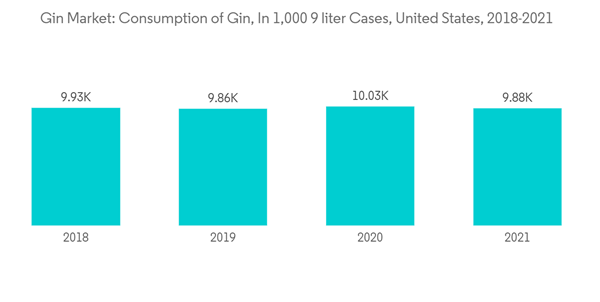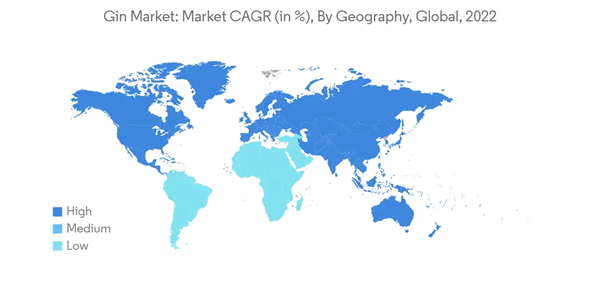The Gin Market size is estimated at 0.86 Billion liters in 2024, and is expected to reach 1.13 Billion liters by 2029, growing at a CAGR of 5.38% during the forecast period (2024-2029).
The rising popularity of premium alcoholic beverages especially among youngsters is one of the major factors influencing the growth of the global gin market. Consumers now carry a passion for mixed drinks and handcrafted cocktails, thereby fuelling the demand for premium cocktails across the globe. For instance, in May 2023, Empress 1908 Indigo Gin launched Empress 1908 Elderflower Rose Gin. This unique gin is handcrafted and distilled with nine unique botanicals including juniper berries, rose petals, elderflower, lavender, orange peel, orris root, cinnamon, coriander, and black carrot. The ruby color is achieved by combining red rose petals and black carrots. Pre-mixed and fresh cocktail recipes are moving away from artificial colorants and flavors in preference for high-quality ingredients with a natural appeal.
In addition, gin consumption is rising among women who are savvy shoppers and younger women are consuming more gin. For instance, according to research by the University of Derby, United Kingdom revealed 57% of gin women increased their consumption of gin over the past two years in the year 2020. Further, gin is valued for its earthy appeal and natural flavor, and most on-trade counters utilize a significant amount of gin to produce high-quality cocktails. As alcohol consumption is rising globally, the market for alcoholic beverages is changing as more distilleries are entering the global beverage business. Therefore, all such factors are supporting the growth of the gin market across the globe.
Gin is popular because it has a natural flavor and lends a drink an earthy appeal. Higher consumption of gin-based cocktails is further ensured by the introduction of contemporary on-trade channels and increased spending on cocktail parties, both of which support the expansion of the global market. For instance, several American gin brands have gained significance and created an excellent brand image among consumers. Therefore, all such factors are propelling the consumption of gin across the globe.
As per data cited by IMF and World Bank, there has been a consistent rise in the overall expenditure made by Asian consumers on alcohol and tobacco products, which has been leading to the growth of the overall market. There has been an estimate made that total expenditure is likely to reach around USD 425 billion by 2025. Further, pubs and bars are specializing in the special cocktail party lounge in response to shifts in consumer preferences. Vodka and gin-based cocktails such as Asian Pear Mule, Whisky Mac, Japanese Highball, Singapore Sling, and Soju Watermelon Cocktail are largely favored by affluent consumers. Thus, such factors are promoting the growth of gin in the Asia-Pacific market over the forecast years.
This product will be delivered within 2 business days.
The rising popularity of premium alcoholic beverages especially among youngsters is one of the major factors influencing the growth of the global gin market. Consumers now carry a passion for mixed drinks and handcrafted cocktails, thereby fuelling the demand for premium cocktails across the globe. For instance, in May 2023, Empress 1908 Indigo Gin launched Empress 1908 Elderflower Rose Gin. This unique gin is handcrafted and distilled with nine unique botanicals including juniper berries, rose petals, elderflower, lavender, orange peel, orris root, cinnamon, coriander, and black carrot. The ruby color is achieved by combining red rose petals and black carrots. Pre-mixed and fresh cocktail recipes are moving away from artificial colorants and flavors in preference for high-quality ingredients with a natural appeal.
In addition, gin consumption is rising among women who are savvy shoppers and younger women are consuming more gin. For instance, according to research by the University of Derby, United Kingdom revealed 57% of gin women increased their consumption of gin over the past two years in the year 2020. Further, gin is valued for its earthy appeal and natural flavor, and most on-trade counters utilize a significant amount of gin to produce high-quality cocktails. As alcohol consumption is rising globally, the market for alcoholic beverages is changing as more distilleries are entering the global beverage business. Therefore, all such factors are supporting the growth of the gin market across the globe.
Gin Market Trends
Infusion of Gin in Premium Cocktails
Alcoholic beverages deal with premiumization leading to greater demand as the younger generation who are constantly looking to explore unique and high-quality alcoholic beverages. Market players are opting for the inclusion of natural ingredients in alcoholic beverages to improve their functionality, which is in turn gathering a lot of attention from consumers. As a result, natural flavors are gaining widespread acceptance to enhance the drink's inherent appeal. Gin is rising in consumption as during social gatherings and festive occasions, millennials try to experiment with gin and other alcoholic beverages. For instance; as per the Beverage Information Group, consumers in the United States consumed nearly 1,510 1,000 9-litre cases of Seagram's Gin in the year 2021.Gin is popular because it has a natural flavor and lends a drink an earthy appeal. Higher consumption of gin-based cocktails is further ensured by the introduction of contemporary on-trade channels and increased spending on cocktail parties, both of which support the expansion of the global market. For instance, several American gin brands have gained significance and created an excellent brand image among consumers. Therefore, all such factors are propelling the consumption of gin across the globe.
Asia-Pacific is the Fastest Growing Region
The Asia-Pacific region is dealing with an increasing number of potential consumers opting for gin as a result of rapid urbanization and westernization. This trend is further influenced by the rising inclination towards partying and booze culture, as more Asian youth consumers are getting involved in drinking habits at an early age, which boosts the demand for gin and related spirits.As per data cited by IMF and World Bank, there has been a consistent rise in the overall expenditure made by Asian consumers on alcohol and tobacco products, which has been leading to the growth of the overall market. There has been an estimate made that total expenditure is likely to reach around USD 425 billion by 2025. Further, pubs and bars are specializing in the special cocktail party lounge in response to shifts in consumer preferences. Vodka and gin-based cocktails such as Asian Pear Mule, Whisky Mac, Japanese Highball, Singapore Sling, and Soju Watermelon Cocktail are largely favored by affluent consumers. Thus, such factors are promoting the growth of gin in the Asia-Pacific market over the forecast years.
Gin Industry Overview
Gin is a clear, strong, aromatic alcohol liquor distilled from rye and other grains and is usually flavored. The global gin market is highly competitive due to multiple regional and multinational companies. Every company adheres to its business strategy to capture the largest possible market share. Along with a review of the industry's competitive landscape, the major players have also been profiled such as Bacardi Limited, Davide Campari-Milano N.V., Diageo plc, Anheuser-Busch Companies, LLC., Pernod Ricard, and William Grant & Sons Ltd. The significant players continuously focus on product innovation with the launch of premium gins to capture consumer interest. These companies are increasing their investments in research and development (R&D), social media marketing, and expanding their geographical presence to maintain their position in the market.Additional Benefits:
- The market estimate (ME) sheet in Excel format
- 3 months of analyst support
This product will be delivered within 2 business days.
Table of Contents
1 INTRODUCTION
4 MARKET DYNAMICS
5 MARKET SEGMENTATION
6 COMPETITIVE LANDSCAPE
Companies Mentioned (Partial List)
A selection of companies mentioned in this report includes, but is not limited to:
- Bacardi Limited
- Davide Campari-Milano N.V.
- Diageo Plc
- William Grant & Sons Ltd.
- Suntory Holdings Limited
- Pernod Ricard
- Radico Khaitan Ltd
- Remy Cointreau
- San Miguel Corporation
- The East India Company Ltd.
- Anheuser-Busch Companies, LLC.
Methodology

LOADING...










